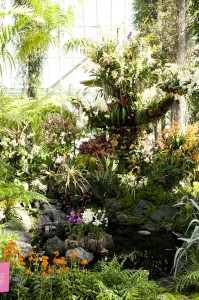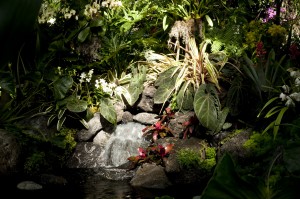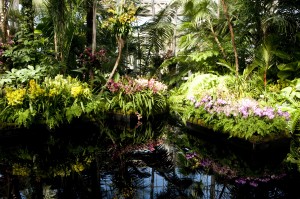Commencement Address: The School of Professional Horticulture Class of 2013
Posted in Around the Garden, Science on March 7 2013, by Robert Naczi
Dr. Robert F.C. Naczi, the Arthur J. Cronquist Curator of North American Botany, at the New York Botanical Garden, delivered the following keynote speech at the School of Professional Horticulture, Class of 2013’s graduation, March 1, 2013. This post features photographs of The Orchid Show which this year has a scientific focus and is designed by Francisca Coelho, the Garden’s Vivian & Edward Merrin Associate Vice President for Glasshouses & Exhibitions and School of Professional Horticulture graduate.
The Critical Importance of Scientific Training to Today’s Horticulturist
 Congratulations to you, the 2013 graduates of the School of Professional Horticulture! You have much to celebrate because you have achieved so much. First, you rose to the challenge of the rigors of the program. For example, in a little over two years, you took over 40 courses, and passed them all. Yes, I know first-hand from you that some of these courses caused you considerable pain, but you made it! You deserve praise, too, for completing a whopping 30 plant walks and all the quizzes that followed them. As well, you completed internships that were, all at once, innovative, demanding, and fulfilling. All through these activities and many more, you excelled at multitasking, delaying gratification, and working really hard. On top of all this, you kept your cool. Sure, each one of you shed blood, sweat, and tears, but you persevered.
Congratulations to you, the 2013 graduates of the School of Professional Horticulture! You have much to celebrate because you have achieved so much. First, you rose to the challenge of the rigors of the program. For example, in a little over two years, you took over 40 courses, and passed them all. Yes, I know first-hand from you that some of these courses caused you considerable pain, but you made it! You deserve praise, too, for completing a whopping 30 plant walks and all the quizzes that followed them. As well, you completed internships that were, all at once, innovative, demanding, and fulfilling. All through these activities and many more, you excelled at multitasking, delaying gratification, and working really hard. On top of all this, you kept your cool. Sure, each one of you shed blood, sweat, and tears, but you persevered.
It is good you persevered. For this is an exciting time to be a professional horticulturist. One of the aspects of your education in the School of Professional Horticulture that sets you above many other horticulturists is your grounding in science. Your foundation in science opens doors for you to a whole range of scientific advances, and will continue to open these doors. Today, I would like to address the promise and power of a scientifically-grounded education in horticulture, such as you now possess.
Yes, you are horticulturists, but you are more–because your feet are firmly planted on the foundation of science. Just remember all those courses you took in science, such as Soil Science, Entomology, Morphology of Flowering Plants, and Systematic Botany.
Let’s review just a few recent advances of science, particularly botanical science, both fundamental and applied. All of these have occurred during the last two decades–the majority of my professional career. So, I have seen the onset of these advances and witnessed their transformative power, because I have had the perspective of working prior to these advances.
– First, the rise of internet-based tools and references, providing assistance with plant identification, images, nomenclature, geographic distributions, and conservation status. It’s amazing how most of these resources have existed for, at most, only 10-15 years, yet they are now indispensable.
– Next, the rise of the field of molecular systematics, which has enabled us to understand relationships among plant families, genera, and species in ways only dreamed about by the last generation of botanists. The result of this improved understanding is an improving classification system–one that better reflects the long-term history of plants and that is becoming highly predictive. A predictive classification allows one to infer unknown attributes of a species, genus, or family from characteristics known in its close relatives, a process vitally important in such matters as drug discovery. Actually, given the number of plant species, estimated at about 300,000, building this natural classification system is a work in progress for me and my fellow systematists, and will be for some time to come–fortunately for us, a form of job security.
– Another advance is the recognition that plants and other organisms provide ecosystem services–processes and products from natural ecosystems that are critical for the survival of human civilizations, such as clean water, pollination, cycling of nutrients, and flood protection.
– The further recognition that non-native species, especially invasive species, often compromise the integrity and health of ecosystems. As a result, these non-native species diminish and, sometimes, eliminate ecosystem services.
– Next, the realization that global change is upon us, and recognition of the important role of plants in making civilizations resilient. For example, nations and municipalities are recognizing the importance of plants in carbon capture and in buffering coasts from the effects of severe storms.
– The final example I will cite is the realization that sustainability planning is essential, especially in the face of resources becoming increasingly limited.
 What do scientific advances such as these, others already made, and those yet to come do for you as a professional horticulturist? Your training in science grounds you solidly in horticulture, and will increase the success rate of your future endeavors. I say this with great conviction and confidence.
What do scientific advances such as these, others already made, and those yet to come do for you as a professional horticulturist? Your training in science grounds you solidly in horticulture, and will increase the success rate of your future endeavors. I say this with great conviction and confidence.
Now, that’s not to say it will be easy. Along these lines, I have a brief story to tell. One of my duties for The New York Botanical Garden is writing the New Manual of Vascular Plants of Northeastern United States and Adjacent Canada. This is a project that will advance the legacy of research and publication on plants of the Northeast that has been a mission of the Garden since its founding. The current book in this series, by Henry Gleason and Arthur Cronquist, is in widespread use by professors, students, gardeners, environmental consultants, and conservationists. Thus, it is an influential and indispensable reference.
Often I am asked the following question by a member of the public when she or he learns I am working on the project: “I’ve heard that some botanists are changing many of the scientific names I have learned. You won’t be changing all those names will you?” I respond in a way that first shocks, but then educates: “Well, not only am I going to use many of those new names, but I am one of those botanists who is changing them. You see, there are good reasons for changing some names, and these changes help us all in the long run.” I go on to explain why the changes are beneficial, for example in creating the predictive classification system that already I have mentioned. Unfortunately, most who ask the question have walked away from me by that point. Many people expect knowledge to be tidily packaged, unchanging, and found in convenient places such as textbooks or Wikipedia.
 You do not belong to that school of thought. You realize that much remains to be discovered, to be created, to be known. This realization gives you purpose, thrills your days, and helps you persevere. I’m sure it is why you enrolled in the School of Professional Horticulture.
You do not belong to that school of thought. You realize that much remains to be discovered, to be created, to be known. This realization gives you purpose, thrills your days, and helps you persevere. I’m sure it is why you enrolled in the School of Professional Horticulture.
I use my little story to make a few points about science. It is often unpopular in larger society. Not only is the pursuit of science difficult, but also, its results often challenge our beliefs and habits. Thus, it can and does make us uncomfortable at times. However, at least in the long run, science usually serves society. Another important point, and this is when I praise the people who ask me questions about plant names, is that scientific advances must be built on rigorous work, and must never be accepted uncritically. Those of us who are scientifically trained, who understand science and how it works, can help our fellow citizens by interpreting science for them.
Now I return to my earlier question, in a specific way. What does science do for you as a professional horticulturist, in your day-to-day work? This is a particularly important question now as you move on to the broader portion of your careers.
Some of you will be working in landscaping and garden design. Your knowledge of plant diversity and morphology give you familiarity with many plant species, genera, and families, enriching the palette of plants from which to choose in your work. As well, ecological studies of plants, especially research on niche characterization and habitat specificity, will enable you to make wise choices of plants and to use available resources effectively–to use the best plants for a particular place. All through this work, you will express your creativity through designing gardens and landscapes whose success rates will be greater than those designed without regard for scientific principles.
 Many of you will work in urban environments. Research on plants in cities is hot, and getting even hotter. Equipped with the knowledge of the latest work and of that yet to come, you will be doing work that makes neighborhoods ever healthier, more beautiful, and more sustainable. Too, you will likely have the opportunity to inform the drafting of future “green” legislation, such as that signed into law on Monday of this week by Mayor Bloomberg that requires increased use of native plants and storm-water-retentive plants in future city plantings.
Many of you will work in urban environments. Research on plants in cities is hot, and getting even hotter. Equipped with the knowledge of the latest work and of that yet to come, you will be doing work that makes neighborhoods ever healthier, more beautiful, and more sustainable. Too, you will likely have the opportunity to inform the drafting of future “green” legislation, such as that signed into law on Monday of this week by Mayor Bloomberg that requires increased use of native plants and storm-water-retentive plants in future city plantings.
Others of you will interact directly with the public, perhaps through outreach and educational programs. With your scientific training, you stand well prepared to create programs that best serve the public. Through such programs, you will help the public understand and appreciate botanical science.
Now, it is traditional for graduation speakers to exhort their audiences, and I will be no different. So, today, I wish to leave you with a few recommendations.
– First, celebrate your accomplishments, especially today on this your graduation day. Be proud of the solid education you have received, with its emphasis on science, for this is one of the things that distinguishes you as a School of Professional Horticulture graduate, and will elevate you above many of your peers in horticulture.
– Continue to embrace the process of inquiry. Actively discover, learn, create, and share what you have learned.
– Continue to study science, learn from it, and incorporate it in your work, despite increasing demands on your time as you assume more responsibilities.
– Use science to inform your work. In this process, be forward-looking. Do your best to anticipate the impact of scientific advances, and position yourselves to take advantage of them.
– Do not cut corners with integrity. Being honest is essential to maintaining credibility and the public trust—for you personally, but also for horticulture. In fact, one of the greatest threats to science today is the erosion of trust resulting from acts of dishonesty by scientists. Help reverse this unfortunate trend by upholding the highest standards of integrity in all your work.
– Whenever you get the chance, in big ways and small, be an ambassador for horticulture, but also for botanical science.
During your careers, in the years ahead, no doubt science will continue to contribute to, and change horticulture. You stand poised to be leaders in horticulture because of the rigor and breadth of your training that included a healthy dose of science. Embrace the challenges of keeping up with scientific advances, employing them in your work, and interpreting them for the public.
The School of Professional Horticulture is a two-year nationally accredited, Title IV participatory school designed to equip students with the skills needed to become the world’s leading horticulturists. The School combines academic studies with hands-on practical training in a full-time program. Through classes, work rotations, group projects, plant walks, field trips, and lectures, School of Professional Horticulture students are able to master the science of horticulture in the classroom and practice what they learn on the Garden grounds. Sound like a challenge you’re up for? Learn more about applying now.

